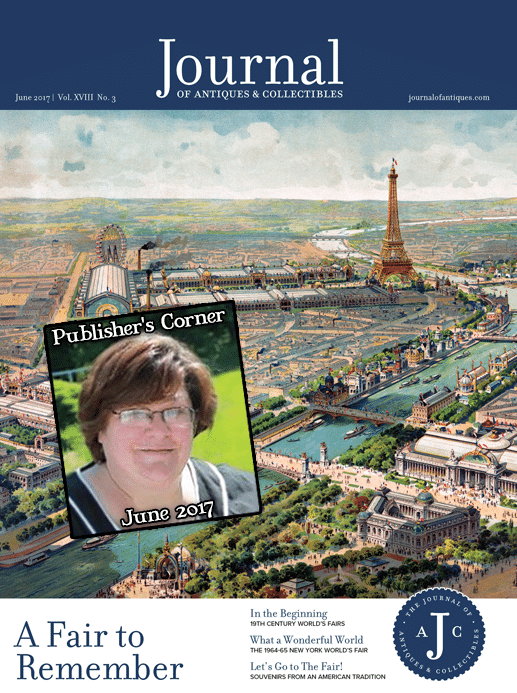A Fair to Remember
By Maxine Carter-Lome
My first World’s Fair was the 1964-1965 New York World’s Fair at Flushing Meadows Park outside of New York City, although I was too young to remember much or appreciate what I saw (I have much more vivid memories of Expo 67 in Montreal). I do, however, have fond memories of the fairgrounds after the fair. As a teenager I went ice skating at the old New York City Pavilion and Ice Theater (the city operated a public arena there until 2008), and I went to numerous events at Terrace on the Park, a structure built by the Port Authority of New York and New Jersey to serve as the heliport for the World’s Fair. Its panoramic view of the city made it a popular catering hall in the 1970s and 80s. The Unisphere, a 12-story-high, stainless-steel model of the earth symbolizing “Man’s Achievement on a Shrinking Globe in an Expanding Universe,” was part of the scenery when passing through Queens on the Van Wyck Expressway and Grand Central Parkway.
It’s easy to see why collecting objects from world’s fairs is such a popular hobby; so many items were made just for that purpose by fair organizers, representative countries, and exhibiting companies. People collect everything from programs, admission tickets, and promotional posters to medals, coins, and company-branded souvenirs of all types and varieties (check out this month’s Appraiser’s Corner for one of the more unique). According to Antiques Appraiser, Author, and Award-Winning TV Personality Dr. Lori, “when it comes to World’s Fair collectibles, the most valuable are those items which highlight the most famous aspects or attractions of a particular World’s Fair,” such as the Crystal Palace in London, the Eiffel Tower in Paris, and the Columbian Fountain in Chicago, to name a few. Read more from Dr. Lori, who joins us with this issue as a regular columnist.
While world’s fairs attract millions of international visitors, the vast majority of Americans in the 19th and 20th centuries were unable to afford the experience. State and regional fairs, however, were more accessible and affordable, and as such are a noted part of American life. Fairs began in the nineteenth century for the purpose of promoting agriculture through competitive exhibitions of livestock and display of farm products. According to Bill Thornbrook in his article Let’s Go To The Fair, among the earliest fairs in the U.S. was a cattle show sponsored by the Berkshire Agricultural Society in Pittsfield, MA, first held in September 1811. The first U.S. state fair was held in 1841 in Syracuse, New York and continues to the present day. In the 20th century, fairs expanded to include amusement rides, Midways with food and carnival games, industrial exhibits, car racing, entertainment, and concerts. Large fairs can admit more than a million visitors over the course of a week or two. Over 3,200 fairs are held in North America each year, each with their own history and catalogue of collectibles, which makes the hobby so interesting and personal to so many.
For those living in the northeast, the “Big E,” also known as The Eastern States Exposition, was, and continues to be, an end-of-summer tradition since 1916. Billed as “New England’s Great State Fair,” it is the largest agricultural event on the eastern seaboard and the seventh-largest fair in the nation. Read more about the history of the Big E by David Cecchi.
With this issue we would like to recognize and celebrate James Dawson of the Unicorn Book Shop in Maryland. Jim has been writing his Collecting Old & Rare Books column for the Journal of Antiques & Collectibles for 15 years! His first article appeared in the May 2002 issue and was on “Collecting Autographed Books.”
“To be honest, when I started I was thinking well, I’d do articles on subjects like children’s books, animal books, cook books, etc. and I’d be lucky to last a year before I ran out of things to write about and have to quit. Imagine my surprise that I’ve come up with so many years’ worth of articles,” shares Jim about this special anniversary. “It helps a lot when I get interesting letters from readers, then the article almost writes itself.” So please – keep those letters to Jim coming!
I am also excited to share that we can now be followed on Instagram at @journal_of_antiques. We launched Instagram during Brimfield so you can see what we see when we go out into the show fields and meet with dealers. We will continue to take you with us through Facebook and Instagram as we visit shows, auctions, and shops throughout the year in our travels. And, we are now publishing a monthly e-newsletter, sent to your Inbox the first of each month. Post-Press Update contains recent features and columns from the magazine as well as additional non-published editorial, highlights upcoming auctions and shows, and shares auction updates and marketplace news received in-between print issues. You can sign up to receive this free newsletter on our website. Look for the Journal Post-Press Update button on our homepage, and find more of what you are looking for.
-
- Assign a menu in Theme Options > Menus WooCommerce not Found





Related posts: